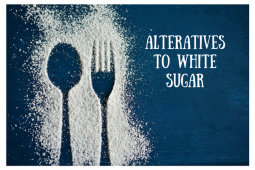What is a Sugar Crash – and How to Recover?

Excess Sugar Often Leads to a Crash, here is Why
Before I discovered healthy eating, I used to keep a small wicker basket containing chocolate bars and sweet snacks in my cupboard. Looking back on those days, a sudden ‘chair nap’ was a frequent result… This was a ‘Sugar Crash’.
This page explains what a sugar crash is. This is common in people with diabetes, though affects everybody. The foods to avoid are covered, as well as some tips for avoiding this type of crash. If you have a sweet tooth, then some alternative sources of sweetness are covered at the end.
What is a Sugar Crash?
Tiredness, fatigue, headaches and even irritability can occur after consuming a lot of sugar. What constitutes a lot depends on several factors. These include what other foods you consume at the same time, whether you are diabetic and individual differences.
A standard scenario works like this: You consume biscuits, chocolate bars or puddings. After 20 minutes (and up to an hour later), you feel suddenly lethargic. A headache or general fatigue kick in, and you feel like having that afternoon snooze!
What is Happening to Your Body?
The scientific term of how excess sugar changes your body is Hyperglycaemia.
Your crash is caused by low sugar in the blood. You need a certain amount to function properly.
Having low blood sugar after downing that bottle of pop (for example) seems backwards. After all, you just poured 20 spoons of sugar down your throat. To understand this, we need to delve into your body’s reaction to all that sugar.

Insulin Spikes Metabolise the Sugar
Excess sugar triggers the release of insulin. This is the same hormone that is behind diabetes. Your body kicks into action to get rid of the sugar very quickly – with a spike in the amount of insulin released.
As a result, the sugar is removed from your blood stream fast. Not only the excess gets removed, the base level you need to function efficiently is lowered. Think of this like an over-reaction of your body to the ‘emergency’ of getting rid of the sugar.
20 minutes to an hour after your sugar binge, you have less than you need in your blood. This is what causes the sugar crash.
What Foods Cause a Sugar Crash?
Sugar is found in many foods. These are not only the obvious candidates like puddings and sweets. Fruits, processed ready-meals, breakfast cereals and cooking sauces all contain high levels of sugar. Low GI carbs (pasta for example) can also cause a crash.
We feel the effects after eating sweets more for these reasons:
- Chocolate and sweets are more likely to be consumed independently, as a snack between meals.
- Many sugary foods, for example milk, are usually consumed alongside other food types.
- The amount of sugar consumed from natural foods is likely to be lower than for sweets. For example, we usually only eat one apple at a time.
A Quick Note on Protein Crashes
Some people also experience a crash after consuming a lot of protein. There is a different mechanism behind this. Instead of blood sugar spiking and then crashing, our bodies choose to focus resources on digestion. In turn, this takes away energy from other activities.
Tips for Avoiding a Sugar Crash
There is one ‘obvious’ tip, which is to avoid foods which include excess sugar. This does not sound like much fun for most people!
For me, chocolate bars and full-sugar coke are a no-go. With no nutritional value I prefer to save my indulgences for sweet foods which are more of a treat. Think a delicious desert after a restaurant meal.
The best way to avoid the crash is to eat a balanced meal along with sweet foods. Proteins, low GI carbs and plenty of vegetables will make anyone feel better.
If you crave sugar, then there are plenty of alternatives to the regular white stuff. Stevia is a popular, along with honey and the many artificial sweeteners out there.
Finally, you might not need as much sugar as you think. I cut this out in both tea and coffee. While they tasted bitter at first – it surprised me how quickly these drinks became delicious again. I really don’t miss it.
Prone to Sugar Crashes? Get Your Insulin Level Checked
If you find yourself particularly prone to sugar crashes, then it might be a good idea to pay your GP a visit. The pancreas, which regulates insulin, and thus blood sugar, is a vital part of your metabolism. Diabetes is very common and can be tested for easily.
Sugar Crashes: Wrapping Up
The body of evidence that processed sugar is harmful to your health is huge (and growing!). While you can still ‘crash’ from natural sources, your overall health can only benefit from avoiding excessive sugars.
Best of all, it is easy to cut down. Start by substituting those snacks with healthy alternatives. Once you feel the benefits, you’ll quickly be motivated to switch to an all-round healthy diet.
More Quick-Fire Food and Fitness Guides:


